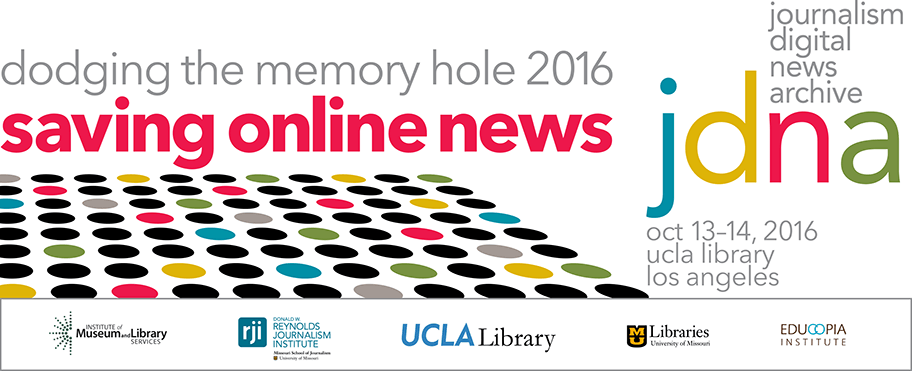
Memory holes and permanent errors: Part 4
Day 4: Conclusions and case studies
This is part four of a white paper, “Memory Holes and Permanent Errors,” which examines whether and how online news archives should preserve corrections, updates and other post-publication changes. Parts one, two and three are available to view, as well as a free PDF download of the full white paper.
Conclusion
What will future generations learn of our time — and our journalism? Already this rough draft of history is patchy and incomplete. Some news articles have been lost forever; many more are under threat. But as librarians, archivists, journalists and technologists begin grappling with how to save valuable news content, they must contend with the many layers news stories acquire over time, like the rings of a tree trunk.
The most critical layer is corrections. To prevent the needless spread of misinformation, articles must be saved together with their related correction notices. In the short term, this could mean that database vendors develop functionality that links corrections and articles or that more publications adopt correction web pages and linking systems akin to those of the New York Times and Los Angeles Times. There doesn’t seem to be commercial demand for these changes, however. So these questions are perhaps better addressed by the next-generation news preservation efforts now being envisaged.
Beyond correction notices, designers of future archival systems will need to make a series of choices about what to save, what to display and how. This includes whether to change errant text, what versions of a story to save, how to display updates (if at all), and when and how to alert readers to edits. We will likely see a tug of war between interests and principles: transparency, accuracy and completeness versus faithfulness to historical record, ease and cost of maintenance, ease of reader use, fear of overwhelming users and the risk of emphasizing marginal aspects of the content.
Perhaps the thorniest debate will be over trust. At a time when confidence in the mainstream media has never been lower and the end of traditional journalistic gatekeeping has enabled the wide dissemination of hoaxes and lies, how can news preservation practices help rebuild reader trust and not further dismantle it? Many would argue that we need nothing less than total transparency: that journalists earn trust by quickly admitting when they’re wrong, clearly correcting the record and opening a window onto the reasons behind their decision-making. But news outlets’ transparency can be turned against them, especially in an era when political leaders are openly hostile towards the media. Witness how Donald Trump misrepresented a post-election letter The New York Times sent to its readers. The letter asked whether the newspaper underestimated Trump, but the president-elect characterized the message as “apologizing for their BAD coverage.” Such episodes of information weaponization give credence to the concern that critics of a particular news outlet could easily cherry-pick a few items from large listings of corrections or edits and represent the outlets as they wish.
My own preference leans toward transparency. As the information ecosystem gets more complex and confusing and readers find it harder to know who to trust, good journalism can point only to its relative ethical strength and sound methods as its distinguishing features. We cannot ask readers to accept those strengths simply on the basis of outmoded authority or of centuries-old names; we must prove it in writing. But the weaponization concerns are valid, and such outcomes should be considered in news preservation planning.
Finally, while news preservation often concerns itself with “the future,” we must recognize that news archives represent a valuable resource in this very moment. News editors are, by nature and title, obsessed with the new; they too easily assume that their readers are always seeking the latest information. But as the recent wave of “explainer” journalism recognizes, readers are often seeking to deepen their understanding. Why did Syria erupt into civil war? What are my taxes being spent on? Is nuclear power safe? Such “evergreen” questions often lead contemporary readers to newspapers’ online archives, but the archives are rarely structured in such a way as to help provide answers. Greater attention to clarity in correction, updates and editing is but one step news websites could take to turn archives into useful, revenue-generating content. In other words, it may just be possible to simultaneously serve readers of the future, and the readers of today.
Appendix A: Case studies
New York Times
The New York Times’ style guide sets out a brief corrections policy that is publicly accessible; this policy addresses the news outlet’s ethical responsibility to correct errors, good practice in correction wording and other generalities (FAQ: Corrections, n.d.). Standards editor Philip B. Corbett says that when it comes to more granular decisions about whether and how to change already-published stories, The New York Times has a set of generally accepted practices but not a policy per se. “I suspect that if you’re searching for a clearly delineated, absolutely set-in-stone policy from us or anyone else, you’re going to be sorely disappointed,” Corbett says. He asserts that “for every rule, there are many exceptions,” so the publication of such rules would only create a situation in which the Times repeatedly broke its own policy.
Corbett says the The New York Times’ fundamental corrections practice is as follows: If there is a factual error in a story online, the outlet will both correct the text of the story and append a corrections note. If the story appeared in print, it will also publish the corrections note in the print version. The Times then sends a corrected version of the story to LexisNexis and other vendors to replace the errant version.
Where Times practices get more controversial is when it makes changes to its article text without notifying readers. These changes occur for a variety of reasons and do not include errors, per se. As Corbett notes, it’s common for online articles, not just at the Times, but throughout the online news universe, to be updated as events unfold. From its infancy, the transitive and real-time nature of online news has lent itself to this function, which offers several advantages for readers. “That’s good for readers because it means that they can come back and read a story two hours later and if anything has happened, or the reporter has had an opportunity to spend more time with it, or has been able to write more details or clarify things, then they get the best version that we can give them.”
In the “overwhelming majority” of these cases, Corbett says, the Times doesn’t flag up the changes for readers. The reason is simply that readers are unlikely to care. “Honestly, I think in the overwhelming percentage of cases, for the overwhelming majority of readers, they don’t care. They come at 3 o’clock in the afternoon, they want to see what can the New York Times tell me about this topic in 3 o’clock in the afternoon. They really don’t care what we told readers about that topic at 10 o’clock in the morning. They don’t care what additional quotes have been added, what other quotes have been taken out to make room for the new quotes, what’s been moved up, what’s been moved down.”
There are other cases, Corbett says, where a story gets substantially revised and the paper chooses to explain the changes to readers in an Editor’s Note. In most of these cases, the first version lacked factual errors but had a significant flaw: for example, it criticized someone but never gave him right of reply. And yes, he says there are times when the news outlet feels it’s best to continue editing after publication. “There’s a school of thought that feels like the news organization should go a lot further in much more routinely walking readers through the fact that a story has changed in some way. I don’t object to that in principle. In principle it’s hard to be against transparency and openness with our readers. But as a practical matter both in technical terms and in terms of how the newsroom functions, and how readers read our material, I think to very frequently be putting notes onto stories saying this story has changed because we had this new information or an editor decided that such and such a point was less important, so he moved it down in the story and moved this other point up instead: Aside from other journalists, and media critics and academics, I’m not sure how many readers would really, truly benefit from that on a routine basis.”
Corbett raises several objections to the proposal for transparent versioning outlined in this white paper. The first, he says, is that rarely do queries about changes come from disinterested, ordinary readers. Instead, they come from media critics, public editors, academics and partisans. Most of these are looking for a reason to criticize Times coverage, he says. “I think there’s a reasonable question … as to whether, if this sort of versioning idea that you’re talking about existed, whether [its] main use … would be to try to undermine our journalism and our editing process by selectively using this data to show, ‘Oh, here’s a case in which they changed this story to add a quote that’s bad for Candidate A,’ or, ‘Here’s a case where they went in and took out a passage that was good for Candidate A,’ or whatever it is.”
Corbett says that perhaps the strongest argument for transparent versioning is its use to researchers. But he points out that this purpose doesn’t align with his own incentives and responsibilities as an editor. “I think that is the strongest argument for that kind of material. But it’s not the top of my priority list, as an editor here in the newsroom today, to think about what’s going to be best for scholars 50 years from now, looking back on the coverage.”
Los Angeles Times
Like the New York Times’ style guide, the Los Angeles Times’ ethics guidelines outline a general approach to corrections. The Los Angeles Times also has a set of internal corrections guidelines, mostly instructions on how to input corrections into the paper’s CMS. The organization’s practice is to append a “For the Record” notice to every errant story but generally not to change the original text. There are a few exceptions: correcting misspelled names, incorrect websites and phone numbers, and typos, for example. In addition, if the Los Angeles Times becomes aware of an error in the time between posting a story online and the end of the print publication day, it will make changes to the online story text. In this case, a correction will be appended to the online story right away, and a For the Record will run in the next day’s print edition.
On online articles, the “For the Record” notice generally appears in a column at the top right of the page, where readers’ represenatitve Deirdre Edgar says it will be difficult for readers to miss. In print, the Times runs corrections every day on page A4. The daily list of print corrections also get posted online at www.latimes.com/corrections, where a web producer usually links them to the original stories, though the Times sometimes falls behind on this task. The news outlet does not post a list of the online corrections it has made.
Edgar says these practices are based on the Los Angeles Times’ philosophy that its publication is part of the public record. Running corrections is transparent, she argues, but changes to the public record are not. “We bite the bullet,” she says. “We’re not in the business of erasing. We’re in the business of publishing.”
Like the NYT’s Phil Corbett, former Los Angeles Times’ assistant managing editor Henry Fuhrmann says Times online articles tend to evolve as more information becomes known. Information could be added or the entire article rewritten from top to bottom. Here, too, the two outlets diverge in their approach. Unlike The New York Times, the Los Angeles Times appends an “Update” notice to alert readers that a change has been made. The Update, which the reporter or editor manually enters into the CMS into its own field, gives the date and time of the change and the general type of change made, such as, “This article has been updated with comment from the White House.”
Fuhrmann’s main objection to widespread public versioning is similar to Corbett’s. “I think it’s a question of signal-to-noise ratio. You’d have so much information; how would you be able to discern what’s useful? … l’d like to see every version of an article if I were really interested in a subject, but for many readers the data would probably be overwhelming.”
About the author

Tamar Wilner is a freelance journalist, researcher and master’s student in the journalism program at the University of Missouri. She specializes in writing about the evolving news media, online misinformation and fact-checking for outlets including the Columbia Journalism Review and Poynter.org, and acting as an occasional consultant for media-focused organizations including the American Press Institute and the Columbia Journalism Review. Her academic research interests include science and health journalism, misinformation effects and audience notions of trust and authority. You can find her at http://www.tamarwilner.com or on Twitter at @tamarwilner.
Wilner completed this white paper in fulfillment of a travel scholarship to attend the 2016 Dodging the Memory Hole Summit, a conference on the preservation of online news, held Oct. 13–14, 2016 at the University of California Los Angeles and arranged by the Donald W. Reynolds Journalism Institute at the University of Missouri. The scholarship was funded by a Laura Bush 21st Century Librarian Program grant (no. RE-33-16-0107-16) from the Institute of Museum and Library Services.
